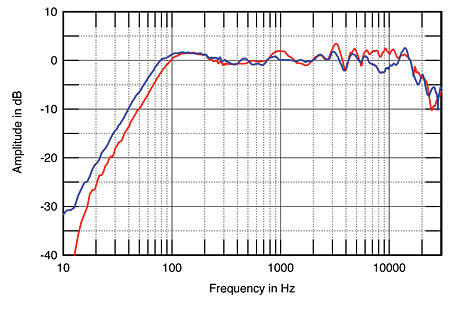| Columns Retired Columns & Blogs |
Snell Acoustics LCR7 XL loudspeaker The Standard LCR7
Sidebar 2: The Standard LCR7
I spent quite a lot of time auditioning a pair of the regular Snell LCR7s (serial numbers 0115 and 0116). These use less-expensive coated paper-cone woofers from SEAS's regular series rather than the magnesium-cone Excel units of the 30th Anniversary XL edition. The tweeter is now a 1" silk-dome unit, and the crossover is different because of the different drivers. The cabinet of wood and aluminum is identical, however, and the speaker seems an excellent value at $2000/pair, particularly if five are to be used for a high-quality home-theater system. (Steve Guttenberg enthusiastically reviewed the LCR7 in this context for the July 2005 issue of our sister magazine Home Theater)
While the standard LCR7 sounds similar to the LCR7 XL, its character made it less suitable for freestanding use in a two-channel system, I felt. Positioned in the same place in the room where the XLs had so impressed me, well away from room boundaries, the LCR7s sounded lighter-balanced, with less low-frequency extension. The speakers still offered the superbly well-defined, stable, stereo imaging that had so impressed me in the Anniversary Edition, but without a subwoofer to flesh out the low frequencies—I found Snell's own ICS Sub300 a good match—the presentation was a bit too relentless in the long term.
It's possible that moving the speakers close to the wall behind them will give a better balance—the rear-panel switch optimizes the lower-midrange behavior for this placement—but my room doesn't allow that option.
Above 300Hz, fig.1 shows the quasi-anechoic farfield response of the XL version with its grille in place (blue trace), and that of the standard LCR7 without its grille (red). Below 300Hz, the graph shows the nearfield woofer response of each. Overall, the two speakers are very similar, taking into account the fact that the presence of the grille on the XL gives rise to a small top-octave peak. However, the standard version both has a little more mid-treble energy apparent on-axis and has less bass extension. Comparing the impedance plots (not shown), the LCR7's woofers are tuned to 87Hz compared with the XL's 70Hz. Its extra low-frequency extension pushes the XL's balance across the line that separates minimonitors that can be used alone from those that need a subwoofer to be musically satisfying. The standard LCR7 fails to cross that line, I feel.

Fig.1 Snell LCR7 without grille (red) and LCR7 XL with grille (blue), anechoic response on tweeter axis at 50", averaged across 30° horizontal window and corrected for microphone response, with the nearfield response of the woofers of each plotted below 300Hz.
The Snell LCR7 is still an excellent-sounding, well-engineered loudspeaker, but can really be recommended for use only with a subwoofer, unless you have a small room.—John Atkinson
- Log in or register to post comments




































